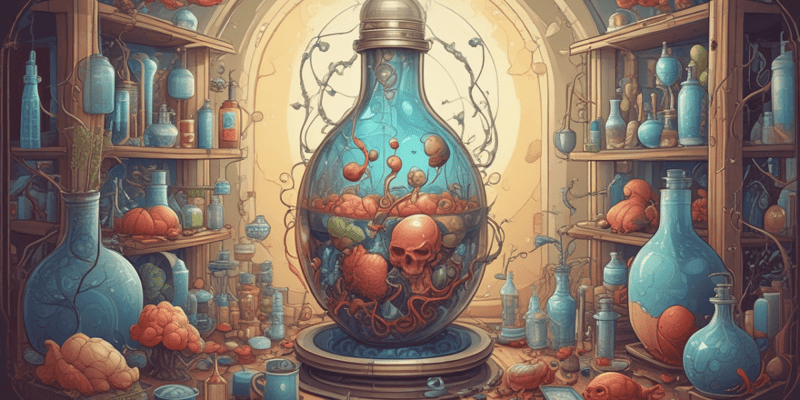20 Questions
What percentage of metabolic fuels is met from carbohydrates?
40-60%
What is the term used to describe the interconversion of chemical compounds in the body?
Metabolism
What type of metabolic pathways are involved in the synthesis of protein from amino acids?
Anabolic pathways
What is the result of abnormal metabolism?
Nutritional deficiency, enzyme deficiency, or abnormal secretion of hormones
What type of metabolic pathways are involved in the breakdown of larger compounds into smaller precursors?
Catabolic pathways
What type of reactions are commonly involved in catabolic pathways?
Oxidative reactions
What is the primary function of amphibolic pathways?
To act as links between anabolic and catabolic pathways
What happens when the intake of metabolic fuels is consistently greater than energy expenditure?
The surplus is stored, largely as triacylglycerol in adipose tissue
What is the dominant hormone in the fed state?
Insulin
What happens to stored energy sources in the fasting state?
They are broken down
In the absence of mitochondria or oxygen, glucose is broken down to which molecule in the cytoplasm?
Lactate
Which pathway is involved in the metabolism of glucose to produce reducing equivalents for fatty acid synthesis?
Pentose phosphate pathway
What is the precursor for the synthesis of cholesterol and other steroids?
Acetyl-CoA
What is the process of synthesizing glucose from non-carbohydrate precursors such as lactate and amino acids?
Gluconeogenesis
In which cellular compartment is the breakdown of glucose to pyruvate occurring in aerobic glycolysis?
Cytosol
What is the primary source of energy for erythrocytes?
Glucose
What is the end product of the citric acid cycle that ultimately yields ATP?
Oxidative phosphorylation
What happens to the carbon skeleton of amino acids during gluconeogenesis?
It is used to produce glucose
What is the product of glycogen breakdown in muscles?
Glucose-6-phosphate
What is the common product that all digested products (glucose, fatty acids and glycerol, and amino acids) are metabolized to?
Acetyl-CoA
Study Notes
Introduction to Metabolism
- Metabolism refers to the interconversion of chemical compounds in the body, including the pathways taken by individual molecules, their interrelationships, and the mechanisms that regulate the flow of metabolites.
- Normal metabolism includes adaptation to periods of fasting, starvation, exercise, pregnancy, and lactation.
- Abnormal metabolism can result from nutritional deficiency, enzyme deficiency, abnormal secretion of hormones, or the actions of drugs and toxins.
- The body constantly requires metabolic fuels throughout the day, which are met from carbohydrates (40-60%), lipids (30-40%), and protein (10-15%), as well as alcohol.
Metabolic Pathways
- Metabolic pathways fall into three categories: anabolic, catabolic, and amphibolic pathways.
- Anabolic pathways involve the synthesis of larger and more complex compounds from smaller precursors, synthesizing protein from amino acids, and reserves of triacylglycerol and glycogen.
- Anabolic pathways are endothermic.
- Catabolic pathways involve the breakdown of larger molecules, commonly involving oxidative reactions, producing reducing equivalents, and ATP.
- Catabolic pathways are exothermic.
- Amphibolic pathways occur at the "crossroads" of metabolism, acting as links between anabolic and catabolic pathways, such as the citric acid cycle.
Energy Balance and Storage
- If the intake of metabolic fuels is consistently greater than energy expenditure, the surplus is stored, largely as triacylglycerol in adipose tissue, leading to the development of obesity.
- If the intake of metabolic fuels is consistently lower than energy expenditure, negligible reserves of fat and carbohydrate, and amino acids leading to emaciation, wasting, and eventually death.
Fed and Fasting States
- In the fed state, carbohydrates, lipids, and proteins are oxidized for the production of energy, and surplus molecules are stored.
- Glycogen synthesis, triacylglycerol synthesis, and protein synthesis occur in the fed state.
- Insulin is the dominant hormone in the fed state.
- In the fasting state, glucagon is the dominant hormone, and stored energy sources are used, including liver glycogen breakdown into glucose, muscle glycogen breakdown into glucose-6-phosphate, and triacylglycerol breakdown into fatty acids and glycerol.
Common Metabolic Pathway
- All digested products (glucose, fatty acids, glycerol, and amino acids) are metabolized to a common product, acetyl-CoA, which is then oxidized by the citric acid cycle ultimately yielding ATP.
Fate of Glucose
- Glucose is the only energy source for erythrocytes and the major fuel of most tissues.
- Glucose can undergo glycolysis, glucogenesis, pentose phosphate pathway, and gluconeogenesis.
- In glycolysis, glucose is broken down to produce energy, either through aerobic glycolysis (producing pyruvate) or anaerobic glycolysis (producing lactate).
- Glucogenesis stores glucose as glycogen.
- The pentose phosphate pathway produces reducing equivalents (NADPH) for fatty acid synthesis and reduction of glutathione and ribose.
Fate of Acetyl-CoA
- Acetyl-CoA can be oxidized to CO2 + H2O via the citric acid cycle.
- Acetyl-CoA is the precursor for the synthesis of cholesterol and other steroids.
Explore the processes of interconversion of chemical compounds in the body, including normal and abnormal metabolism, and its regulation. Discover the impact of various factors on metabolism, such as nutrition, enzymes, and hormones.
Make Your Own Quizzes and Flashcards
Convert your notes into interactive study material.
Get started for free



